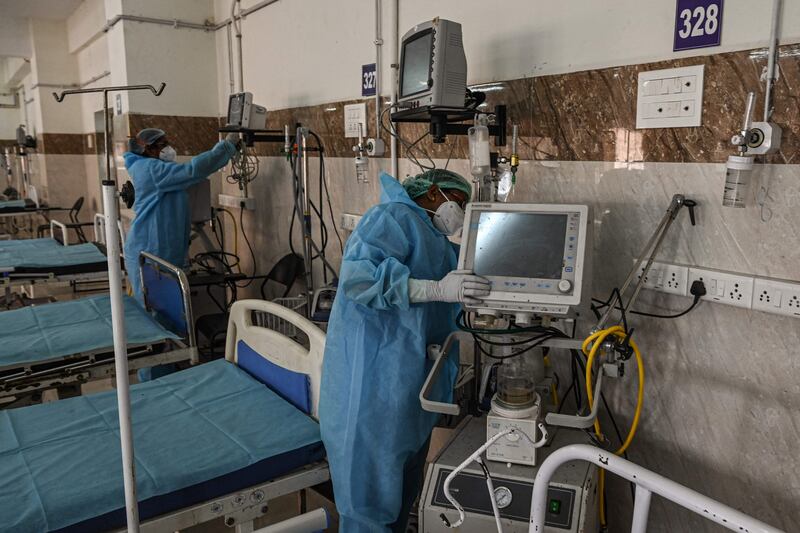Omicron could cause much less severe illness and 80 per cent fewer hospitalisations, according to a new study based on the variant’s surge in South Africa and the latest data from the UK.
The South African study, released on Wednesday, also suggests its very high transmissibility causes cases to peak and decline far more quickly than occurs with waves of the Delta variant.
Its findings have stirred a heated debate within the scientific community as to how badly Omicron will strain healthcare systems around the world.
Many scientists are urging caution on data suggesting it may be less harmful, because the virus is still a building wave in much of the world and the reporting of cases and deaths can lag behind its spread.
They said that even if Omicron causes less severe illness in most people, the sheer number of infections could overwhelm hospitals.
While a study on Monday by scientists at Imperial College London said there was no evidence that Omicron caused less severe illness the country's latest reports threw the findings into question.
The newest report from the university, also released on Wednesday, found that people with Omicron were 15 to 20 per cent less likely to visit the hospital and 40 to 45 per cent less likely to require an overnight stay than those who had been infected with the previous Delta strain.
But it was 10 times more likely than Delta to infect people who had already contracted Covid-19, researchers in Scotland found.
The latest findings from Imperial College London and South Africa’s National Institute of Communicable Diseases join a growing number of studies that paint a more optimistic picture of the latest wave than previous.
Last week, a study by the Cambridge Institute of Therapeutic Immunology and Infectious Diseases said early findings suggested Omicron was less effective at damaging the lungs compared with prior variants.
The study said Omicron “has gained immune evasion properties whilst compromising on properties associated with replication and pathogenicity [harm]”.
It followed similar findings by the University of Hong Kong, released on December 15, that “Omicron infection in the lung is significantly lower than the original Sars-CoV-2, which may be an indicator of lower disease severity”.

But the Hong Kong study authors also said: “By infecting many more people, a very infectious virus may cause more severe disease and death even though the virus itself may be less pathogenic.”
The South African study authors said that while more study was needed, the data from South Africa – whose experience is being watched around the world – told a “positive story” about the variant’s severity.
Drop in Omicron cases
Omicron was first detected in Gauteng, South Africa’s commercial hub and home to one of the continent’s busiest airports.
Cases in the region are falling, as is the percentage of positive tests, Michelle Groome, of the NICD, told a news briefing.
“Really, we feel that this has persisted for over a week and that we are past the peak in Gauteng,” she said.
There had been a “levelling off” in three other provinces – Limpopo, North West and Mpumalanga – she said, though cases were increasing elsewhere. Dr Groome said the fall in case numbers could be due, in part, to lower levels of testing during the holiday period.
South Africa has imposed the lowest level of a five-tier system of restrictions, despite a rapid surge in infections. But hospital admissions are being monitored closely.
While these have also risen, they have remained far below the levels seen during previous waves of the pandemic, with deaths also lower than seen in the past and people staying in hospital for shorter periods, the NICD’s Dr Waasila Jassat said, with the caveat that relevant data tended to lag.
Infections in the first four weeks of the fourth coronavirus wave, driven by Omicron, rose well above those seen in the previous three waves, NICD data showed. But the proportion of people admitted to hospital stood at 5.7 per cent, compared with above 13 per cent in previous waves.
The proportion of people admitted to hospital who later died dropped to 5.6 per cent, compared with 19 per cent or above in the first, second or third waves.
Of people who died of Covid-19 in South Africa between November 7 and December 18, 87 per cent were unvaccinated or had received only one dose, the data showed.
The South African study used data from four sources: national Covid-19 case data reported to the NICD, public sector laboratories, one large private-sector lab and genome data for clinical specimens sent to NICD from private and public diagnostic labs across the country.
But the study included several caveats and cautioned against jumping to conclusions about the intrinsic characteristics of Omicron.
“It is difficult to disentangle the relative contribution of high levels of previous population immunity versus intrinsic lower virulence to the observed lower disease severity,” they wrote.
Paul Hunter, a professor of medicine at Britain’s University of East Anglia, described the South African study as important. He said it was the first properly conducted study to appear in pre-print form on the relative severity of the Omicron and Delta variants.
He said its main weakness was that it compared Omicron data from one period with Delta data from an earlier period.
“Even though cases of Omicron were less likely to end up in hospital than cases of Delta, it is not possible to say whether this is due to inherent differences in virulence or whether this is due to higher population immunity in November compared to earlier in the year,” he said.
“To a certain extent, this does not matter to the patient who only cares that they won’t get very sick. But it is important to know to enable improved understanding of the likely pressures on health services.”


















